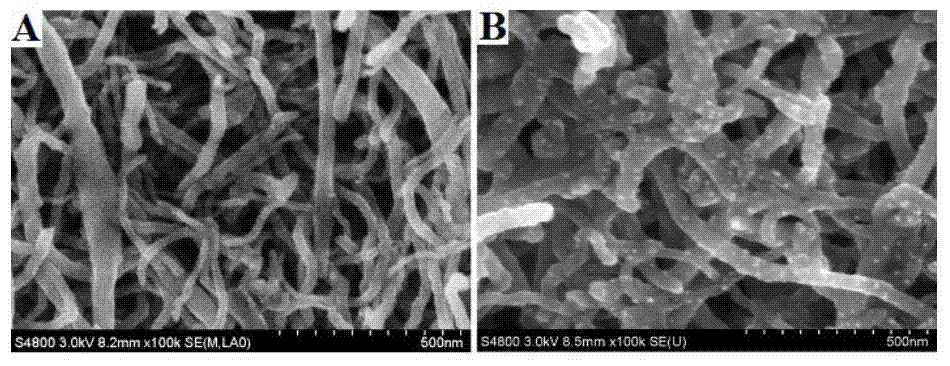Carbon nano tube/nanogold composite membrane electrochemical immunosensor and application thereof
An immunosensor and carbon nanotube technology, applied in the field of electrochemical analysis, can solve the problems of complicated operation, narrow linear range, low sensitivity, etc., and achieve the effects of good selectivity, high accuracy and high sensitivity
- Summary
- Abstract
- Description
- Claims
- Application Information
AI Technical Summary
Problems solved by technology
Method used
Image
Examples
Embodiment 1
[0025] Example 1 Preparation of carbon nanotube / gold nanocomposite film and its immunosensor
[0026] The first step: glassy carbon electrode (diameter 3 mm) with Al 2 o 3 Polish to a mirror surface, and then ultrasonically clean with acetone, nitric acid solution (1.0 mol / L), sodium hydroxide solution (1.0 mol / L) and double distilled water for 5 min. After the treated glassy carbon electrode was blown dry, 10 μL of carbon nanotube solution was drip-coated and dried under an infrared lamp. The prepared glassy carbon electrode / carbon nanotube was placed in a sulfuric acid solution containing 0.10 mmol / L chloroauric acid ( 0.50 mol / L), deposited nano-gold on the electrode surface by multi-potential step method (scanned for 15 s in the step potential range of 1.055 ~ –0.045 V) to prepare glassy carbon electrode / carbon nanotube / nano-gold. use;
[0027] Step 2: After the modified electrode was washed with double distilled water and dried, 10 μL of microcystin antibody was applie...
Embodiment 2
[0030] Example 2 Constructing an electrochemical immunosensor based on a carbon nanotube / gold nanocomposite film for the detection of microcystins in water
[0031] After the immunosensor was cleaned and dried, it was put into a certain concentration of microcystin solution and incubated at 37 oC for 60 min. After washing the electrode with PBS, 10 μL of horseradish peroxidase-labeled microcystin antibody was dropped on the surface of the electrode and incubated for 60 min. Then, the electrode was washed with water and placed in 5 mL of PBS containing 0.80 mmol / L hydrogen peroxide and 0.50 mmol / L hydroquinone, and quantitatively detected by differential pulse voltammetry with a scan range of 0.40 to –0.6 V. Using hydroquinone as the electron mediator, the detection of microcystin was realized through the response current generated by hydrogen peroxide catalyzed by horseradish peroxidase.
[0032] image 3 is the response current map of the electrochemical immunosensor based ...
PUM
 Login to View More
Login to View More Abstract
Description
Claims
Application Information
 Login to View More
Login to View More - R&D
- Intellectual Property
- Life Sciences
- Materials
- Tech Scout
- Unparalleled Data Quality
- Higher Quality Content
- 60% Fewer Hallucinations
Browse by: Latest US Patents, China's latest patents, Technical Efficacy Thesaurus, Application Domain, Technology Topic, Popular Technical Reports.
© 2025 PatSnap. All rights reserved.Legal|Privacy policy|Modern Slavery Act Transparency Statement|Sitemap|About US| Contact US: help@patsnap.com



